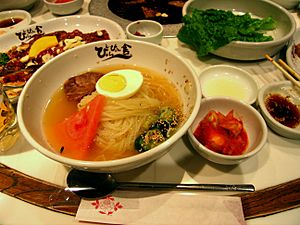Morioka Reimen facts for kids
 |
|
| Alternative names | Morioka Cold Noodle |
|---|---|
| Type | Noodle |
| Place of origin | |
| Region or state | Morioka, Iwate Prefecture |
| Associated national cuisine | Korean |
| Created by | Teruhito Aoki (Japanese: 青木輝人) |
| Invented | 1954 |
| Variations | Naengmyeon |
| Similar dishes | Hamhung Cold Noodles |
Morioka Reimen (Japanese: 盛岡冷麵) is a super popular cold noodle dish from Morioka, a city in Iwate Prefecture, Japan. It's one of the "Three Great Noodles of Morioka", alongside Morioka Jajamen and Wanko soba. People love it for its chewy noodles, tasty cold soup, and spicy kimchi toppings. This dish was inspired by Naengmyeon, a similar cold noodle dish from Korea.
Contents
What is Morioka Reimen?
The noodles in Morioka Reimen are special. They are made from potato starch, wheat flour, and a bit of white buckwheat flour. These noodles look a little see-through. They get their super chewy texture because they are made using a special machine called an extruder. This machine pushes the dough through small holes.
The soup, called broth, is also very important. It's made from a mix of chicken and beef stock. Soy sauce and dried shiitake mushrooms are added for extra flavor.
Morioka Reimen is usually topped with a hard-boiled egg, slices of beef shank or chashu pork, fresh cucumber, and spicy kimchi. You might even find seasonal fruit like apple or watermelon on top, which adds a sweet and refreshing touch!
How Morioka Reimen Started
The idea for Morioka-style cold noodles came to Japan thanks to a person named Yang Yongcheol (Korean: 양용철; Hanja:楊龍哲). He was born in 1914 in Hamhung, which was part of Korea at the time. Today, Hamhung is in North Korea.
In March 1938, Yang Yongcheol moved to Japan. Later, in 1940, a new law called Sōshi-kaimei was put in place. This law meant that many people had to change their names. So, Yang Yongcheol became known as Teruhito Aoki (Japanese: 青木輝人).
In 1954, Aoki opened a yakiniku restaurant called Shokudoen (食道園). Yakiniku is a type of Japanese barbecue. He decided to add cold noodles to his menu. He used his memories of the food from his hometown to create the taste, using ingredients he could find in Japan.
Slowly, these cold noodles became very popular in Morioka. Other restaurants started making them too. By the mid-1980s, the noodles became famous all over Japan. They began to be called "Morioka Reimen" to show where they came from.
How is it Different from Korean Noodles?
Morioka Reimen is similar to Korean Naengmyeon, but there are some differences.
For example, the noodles in Pyongyang Naengmyeon are mostly made from buckwheat flour. They are also thinner. Morioka Reimen noodles, however, are mainly made from potato starch, which gives them their clear look and strong, chewy texture.
There are two main types of Naengmyeon from Hamhung, Korea:
- Bibim Naengmyeon (Korean: 비빔 냉면; "mix cold noodles") is served without broth. Instead, it's mixed with a spicy chili paste.
- Mul Naengmyeon (Korean: 물냉면; "water cold noodles") comes in a clear broth. This broth often mixes beef broth with dongchimi, which is a type of radish water kimchi.
While the broth is different, the chewy texture of Morioka Reimen noodles is quite similar to Hamhung cold noodles. However, Morioka noodles are usually thicker.
Gallery






